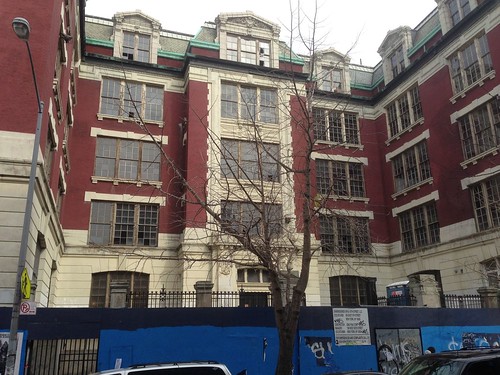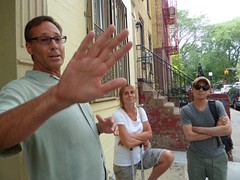On the heels of an application to convert the former P.S. 64 building into college dorms, Villagers are again calling for the historic building to be used for non-profit organizations and low-income housing.
“The building was an arts and cultural center, and it really needs to be returned to that,” said Carolyn Ratcliffe, a member of Community Board 3 who is also vice president of the Lower East Side Preservation Initiative and a member of the Ninth Street Block Association.
Ms. Ratcliffe, who protested the eviction of the CHARAS/El Bohio community center in 2001, questioned the intentions of Gregg Singer, the developer who bought the building from the city in 1998 and has been clashing with local residents and elected officials ever since. “He has not been a good neighbor in the past,” she said.
Frank Morales, a long-time housing activist who has led numerous discussions about the building’s future, is hopeful that community members can reclaim it. “The former P.S. 64 needs be converted into low-income and affordable housing for those in need,” he said, “as we are amidst a deep crisis in this city regarding the lack of accessible housing for poor and working-class people, a situation that we intend to change and reclaiming Charas back from the speculators is part of that plan.”
Others are taking a wait-and-see approach regarding the proposal for a five-story dorm, which hasn’t yet been approved by the department of buildings. Andrew Berman, executive director of the Greenwich Village Society for Historic Preservation, was among the preservationists and politicians who pushed for the 107-year-old school building to receive landmark status. “Given the owner’s awful record in terms of past plans for the building and his horrible stewardship of this landmark property, we will be keeping a very close eye on any new plans he pursues,” he told The Local this week, noting that the landmarking of the building in 2006 as well as height restrictions imposed on the East Village in 2008 would limit Mr. Singer’s options.
The developer, who in 2006 was criticized for stripping the building of some of its French Renaissance Revival details, declined to comment on his current plans, as did the project’s architect. This much is certain: they’ll have to seek the Landmark Preservation Commission’s approval for any aesthetic changes (the city supreme court rejected a challenge to the building’s landmark status in 2008). In October, Community Board 3 declined to support an application to replace the building’s wooden window frames with aluminum ones, noting that it was once “the heart and soul of the Lower East Side community.”
Sara Romanoski, director of the East Village Community Coalition, said the organization — formed in 2004 during the push to preserve the building — planned to work closely with Community Board 3, the Ninth Street Block Association, and other groups to make sure whatever happened improved the quality of life for East Village residents. “We have obviously had a conflict with N.Y.U. before, around dormitories coming into the neighborhood,” she said. “We don’t want to lose our voice about something that’s caused so much heartache, and we’ve put so much time and energy and heart into over the years.”
That sentiment was echoed by the Museum of Reclaimed Urban Space, which stated that “turning the community center into private university housing not only goes against the landmark and deed limits for the property, but also the wishes of the local community, who desperately need alternative community spaces.”
Both New York University and The New School said they were not involved with the property. Cooper Union has not yet responded to The Local’s inquiry. Last week, a representative of Kayne Anderson Real Estate Advisors, which had been negotiating to bring dorms to an unidentified Lower East Side school building, told The Local that “nothing has been acquired at this point” at 605 East Ninth Street.
A provision of the property deed demands that the building be used as a community facility — meaning a facility that, per the Department of Buildings, “provides educational, health, recreational, religious or other essential services for the community it serves.” Although this includes college dormitories, Mr. Singer was denied the last time he applied for a permit to build one, on the grounds that he didn’t have a school committed to leasing the space. The proposal for a 23-story and later a 19-story dorm was seen as a red herring that would allow him to turn the building into market-rate housing after construction was completed.
During the 1980s and ’90s, the building housed after-school programs, office space for non-profit organizations, theatrical space, art galleries and studios — most of them in the service of the Latino community. “Charas served a real vital purpose in our community,” said Ms. Ratcliffe. “It’s been such a loss, because artists have been under siege here. We have no viable place between Houston and 14th Street to go.”
For now, the organization’s former home remains vacant. Tuesday night, a reporter heard clanging noises coming from the top of the five-story structure. Ms. Ratcliffe worried that large pieces of metal hanging from the building could fall and harm passersby. She said she had voiced complaints to Council Member Rosie Mendez and others about the state of disrepair.
Correction, Feb. 21, 2013: An earlier version of this post misidentified Carolyn Ratcliffe as a former member of Community Board 3. She is still a member of the board.





